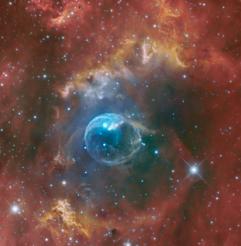Modelling the stellar winds from hot and cool stars

- NGC 7635 (The Bubble Nebula) - A strong stellar wind and intense radiation from a star has blasted out the structure of glowing gas against denser material in a surrounding molecular cloud.

- © Bernard Michaud
Dr. Jonathan Mackey
(Argelander-Institut für Astronomie, Universität Bonn)
Dienstag/Tuesday, 2014-12-09 14:00 c.t., EW 229
Eugene-Paul-Wigner Gebäude, Hardenbergstr. 36, 10623 Berlin
Zusammenfassung/Abstract:
Mass loss from massive stars is very important for determining their evolution and death, but their wind properties can be difficult to measure and are often very uncertain.
Main sequence massive stars have fast and highly ionized winds, driving bubbles in their surroundings that have proven surprisingly difficult to detect. We have run simulations showing that wind bubbles are typically very asymmetric and do not fill their HII regions.
X-ray emission from the shocked wind is very weak, about 0.1% of the input energy, with the rest being dissipated by mixing with cooler photoionized gas. It appears likely that arcs of infrared emission (often seen within HII regions) can be explained as the outer edges of asymmetric wind bubbles, and this can potentially be used to constrain stellar wind strength. After the main sequence, massive stars evolve to cool red supegiants. These emit few ionizing photons, but most of them live in photoionized regions of space and so their cold and dense winds are ionized from the outside in. Betelgeuse is a runaway star and its wind produces a bow shock at a radius of about 0.35pc, but unexpectedly it also has a static shell at a radius of 0.12pc. We show that a model in which Betelgeuse's wind is externally photoionized can explain the static shell without requiring a new understanding of the bow shock. An ionization front in the wind generates the static shell, and the wind-ISM interaction generates the bow shock. Up to 35% of the stellar wind can be trapped in the static shell. In extreme cases the shells can dramatically affect supernova lightcurves.

